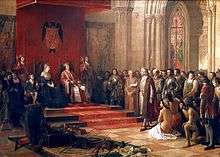Dynastic union
A dynastic union is a type of federation with only two different states that are governed under the same dynasty, while their boundaries, their laws, and their interests remain distinct.[1] It differs from a personal union in that a personal union is specifically under one monarch, but a dynastic union requires 2 monarchs.

Union of Kingdom of Aragon and Kingdom of Navarre
With the assassination of Sancho IV, Navarre was invaded by his cousins Alfonso VI of Castile and Sancho V Ramirez of Aragon, and the latter made king in 1076, leading to more than half-a-century (1076–1134) of Aragonese control.
Union of Kingdom of Aragon and County of Barcelona
Marriage of Count of Barcelona Raymond Berengar IV of Barcelona and future Queen of Aragon Petronila of Aragon in 1137 that formed the Crown of Aragon.[2][3]
Union of Crown of Castile and Crown of Aragon
Marriage of Isabella I of Castile and Ferdinand II of Aragon in 1469 that laid the foundations for the kingdom of Spain. They didn't ascend to their respective thrones until 1474 and 1479 respectively.[4]
Union of Kingdom of Spain and Kingdom of Portugal
Dynastic union between Spain (the union between the Crowns of Castile and Aragon) and Portugal (1580–1640),[5] generally called the Iberian Union by modern historians, under the Philippine Dynasty.
Union of Grand Duchy of Lithuania and Kingdom of Poland
Marriage of Jogaila and Queen Jadwiga of Poland on 1385, generally called the Union of Krewo. That union laid the foundations for the eventual formation of the Polish–Lithuanian Commonwealth.
Union of Kingdom of France and Kingdom of Navarre
Following Salic law, Henry III, King of Navarre, a member of the House of Bourbon, succeeded to the French throne in 1589 upon the extinction of the male line of the House of Valois. Both houses were cadet branches of the Capetian dynasty, the ruling house of the kingdom of France since 987.
Union of Kingdom of England and Kingdom of Scotland
When Elizabeth I of England died in 1603, the heir to the English Throne was King James VI of Scotland. Generally called the Union of the Crowns, this dynastic union was in place from 1603 until 1653 (when the monarchy was officially abolished) and again from 1659 until the two nations were politically united in 1707.
References
- Lalor, ed. Various authors. See Contents. Cyclopaedia of Political Science. New York: Maynard, Merrill, and Co., ed. John Joseph Lalor, 1899.
- John C. Shideler. "A Medieval Catalan Noble Family: the Montcadas, 1000–1230". Retrieved 24 April 2008.
- Cateura Benàsser, Pau. "Els impostos indirectes en el regne de Mallorca" (PDF). Archived from the original (PDF) on 3 October 2008. Retrieved 24 April 2008. El Tall dels Temps, 14. (Palma de) Mallorca: El Tall, 1996. ISBN 84-96019-28-4. 127pp.
- H. J. Chaytor. "Juan II. Union of Aragon with Castile". A History of Aragon and Catalonia. Retrieved 17 April 2008.
- Stanley G. Payne. "Chapter Ten, The Expansion". A History of Spain and Portugal, Volume 1. Retrieved 24 April 2008.